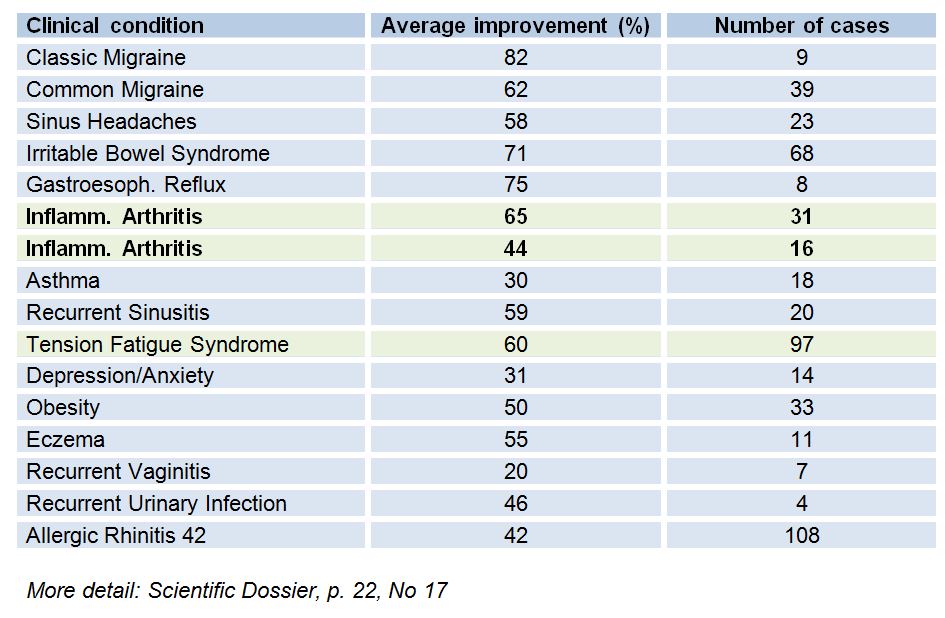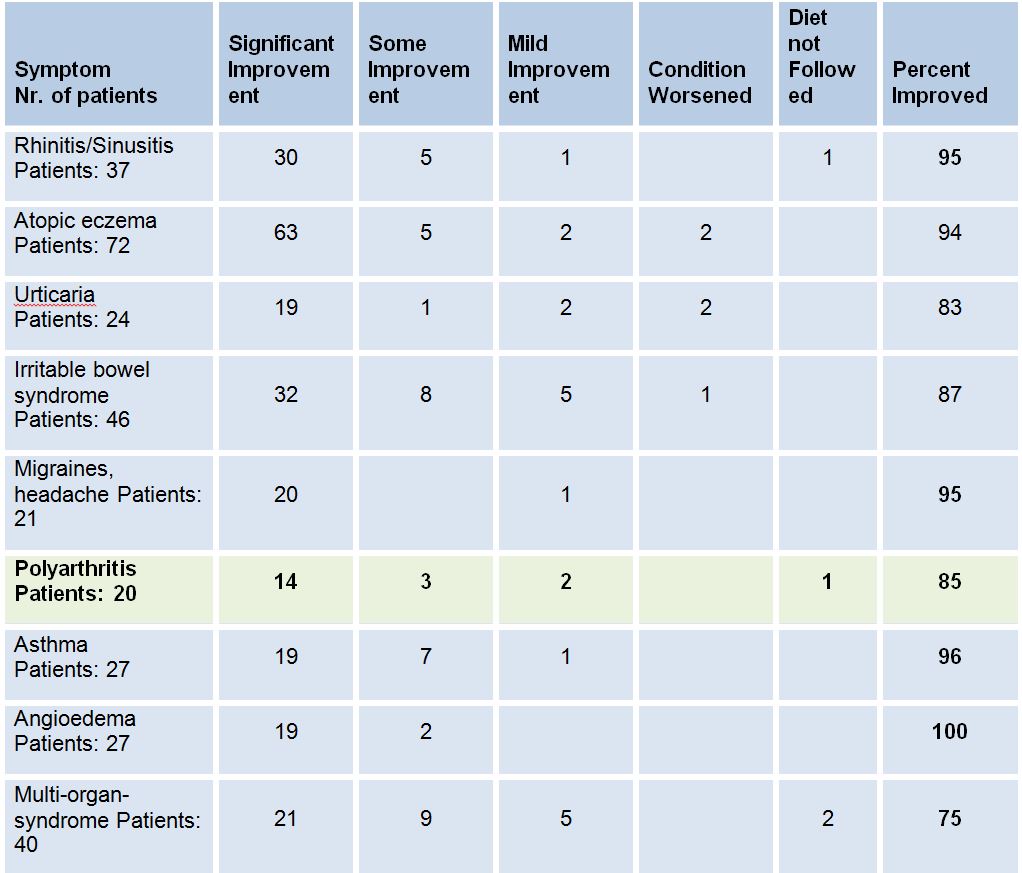Musculoskeletal Health
“I was diagnosed with Rheumatoid Arthritis at the age of 9. Since that time, I went through years and years of excruciating pain and was given medications from IVs, Cancer drugs, Injections, and many more. I studied Naturopathic Medicine to learn more about my condition. After years of fatigue, pain and suffering, after taking the Alcat Test, I found that my Arthritis was caused by gluten and garlic in my diet. After taking this out of my diet, adding supplements, and exercise, I now have no signs of my previous diagnoses and give all of the credit to the test results of the Alcat Test. I strongly recommend this to my patients to understand what the root cause is of their medical condition.”
(Saira Gillani, ND, MBA, CTN, CNW -Natural Health Atlanta).
Inflammatory joint conditions are no longer age complaints 1, 2. Especially with gouty arthritis specialists have known for a long time the importance of proper nutrition and the potential relationship between food and the progress of the disease 3. Foods containing purine (such as meat, poultry, fish, eggs, etc.) may promote the deposition of uric acid crystals in the joints and therefore aggravate the symptoms.
What foods may cause arthritis? The body can react to any food; therefore any food which may induce inflammation can potentially aggravate arthritis. This includes rheumatoid arthritis (RA), juvenile arthritis, and undefined joint pains. This is why it can be complex to recognize the relationship between diet, inflammation and their symptoms.
The Alcat Test can, in many cases identify inflammatory dietary triggers. The customized dietary recommendations will help lifestyle changes with the goal to reduce inflammation in the body and strengthen the immune system. (Link to alcat test).
Other benefits may include more efficient detoxification of the body. If the immune system can be unburdened it maybetter eliminate toxins and metabolic waste resulting in improved overall health.
Arthritis
Arthritis involves inflammatory processes in one or more joints. It should be distinguished from the degenerative disease osteoarthritis. There are 19 different forms of Arthritis. The most common are as follows:
Rheumatoid arthritis
RA is a chronic, inflammatory condition also named polyarthritis that comes along with strong, persistent pain in (multiple) joints, due to a misdirected immune system. The so called “Bermuda triangle” of genetics, environment and autoimmunity is involved in the pathogenesis of rheumatoid arthritis (RA) 4.
The causes are still unclear and it can affect many different joints and, in some people, other parts of the body as well, including the blood, the lungs, and the heart. Inflammation of the joint lining can cause pain, stiffness, swelling, warmth, and redness. The affected joint may also lose its shape, resulting in loss of normal movement. RA can last a long time and can be a disease of flares (active symptoms) and remissions (few to no symptoms). RA affects approximately 0.5% of the population worldwide 1. This disease is more common in women than in men, and generally affects people between the peak ages of 50 to 60 1. It is not a symptom of old age as assumed very often, but can occur at any age 1. However, young children can develop a form of RA called juvenile rheumatoid arthritis.
Arthritis urica, gout
Gout indicates a clinical condition, which is caused by a disturbed purine metabolism. This involves the uric acid crystals in the peripheral joints and tissues and causes an inflammatory reaction with the painful symptoms 5. Longer-lasting symptoms lead to cartilage changes and damage to the kidneys.
Infectious/ septic arthritis
Infectious arthritis is acute and it is caused by bacteria, fungi, viruses or any other infectious agent 6.
Psoriatic Arthritis
In this form the inflammatory skin disease psoriasis extends to the joints. The underlying immunopathogenic pathway(s) is/are not yet understood but are beimg investigated..
Osteoarthritis (OA) is the most common form of arthritis in the United States, affecting an estimated 27 million adults 7. OA begins with the breakdown of joint cartilage, resulting in pain and stiffness. OA commonly affects the joints of the fingers, knees, hips, and spine. Other joints affected less frequently include the wrists, elbows, shoulders, and ankles. When OA is found in a less-frequently affected joint, there is usually a history of injury or unusual stress to that joint. Work-related repetitive injury, physical trauma, sex, genetics and obesity may contribute to the development of OA 8.
Fibromyalgia
Fibromyalgia is an arthritis-related condition that is characterized by generalized muscular pain and fatigue. The term “fibromyalgia” means pain in the muscles, ligaments and tendons. This condition is referred to as a “syndrome” because it’s a set of symptoms that occur together. Fibromyalgia is especially confusing and often misunderstood condition. Because its symptoms are quite common and laboratory tests are generally normal, people with fibromyalgia were once told that their condition was “all in their head.” However, medical studies have proven that fibromyalgia does indeed exist, and it is estimated to affect about 1-5% of the population 9.
While there is no specific diet for all fibromyalgia cases, different symptoms may suggest ways of improving your health through diet. As fibromyalgia sufferers often have one condition amplifying another (or several others), relieving even one can increase your quality of life, sometimes substantially. If your body overreacts to certain foods, it could worsen conditions ranging from digestive troubles (gas, bloating, constipation, or diarrhea) to fatigue, headache or migraine, joint pain, mood disorders, muscle aches, and skin problems 9, 10.
The advantage of the Alcat Test is that it allows you an inside look at how your body reacts to the food you eat. Many of the varied symptoms related to fibromyalgia may be eased by adjusting your diet.. Currently there are not many viable options to treat fibromyalgia through pharmaceuticals means. Many sufferers are finding success with dietary changes though. The Alcat Test provides a unique blood test to identify potential inflammatory dietary triggers; it offers an entire program..
Test recommendations for musculoskeletal or inflammatory joint conditions
|
What test? |
Why? |
|
Alcat Test for food & chemical sensitivity
PreviMedica Program
LINKs
|
Validation studies show that the Alcat Test can have very positive effects on inflammatory conditions:
|
| Gut Health Profile (GHP)
LINK to GHP |
|
| Adrenal Stress Profile | Stress can cause inflammation.
|
| Vitamin D |
|
Effectiveness and validation of the Alcat Test
Beginning in 1988, and carrying through to the present, several clinical studies have been performed to evaluate the effectiveness of the Alcat Test. Some of which were “double-blinded*” to see how well the test results correlate with actually eating the food.
A valid test for food intolerance should show the effect of food substances on those cells of the immune system which are associated with the inflammatory process.
(Note to us: it would be good to link to references that link neutrophil activation to certain disease conditions, LINK to Alcat Test immunology section?).
If the test results are valid there should be in a concordance with symptoms (e.g., gastrointestinal complaints), and correlate with double blind oral exposure.
(*Double-blind studies: Ideally the study should be carried out in double blind fashion, wherein neither the doctor (investigator) nor test subject knows whether the food they are re-introducing is test positive or test negative. The test results are evaluated to see if they correlate with this, the, “gold standard” – a double blind oral challenge. This is a rigorous and time consuming protocol that yields an objective evaluation of both the sensitivity and the specificity of the test.)
Why is that important?
This is important because you want the test to correctly identify reaction provoking substances; but, you also do not want the test to show false positives. The first parameter is called, “sensitivity”. The second is called, “specificity”. A false positive would cause you to needlessly eliminate a safe food. Why go through the trouble and deprivation?
Scientists have shown that in patients with irritable bowel syndrome, atopic eczema, allergic rhinitis or migraine the Alcat Test can detect those foods that cause the above symptoms. The Alcat Test has shown an impressive consistency in the double-blind study of 83.4% for foods. With standardized non biological substances, the accuracy is as high as 96%.
Link studies
- High Correlation of the Alcat Test Results with Double-blind Challenge (DBC) in Food Sensitivity (P. Fell, Bostoff et al, 1988 and published in the Annals of Allergy)
- Diagnostic Value of Alcat Test in intolerance to food additives compared with double-blind placebo-controlled (DBPC) oral challenges ( Hoj, J Allerg Clin Immun 1 (3); 1996)
More detail: Scientific Dossier p. 14-16
Reproducibility of the Alcat Test
- Drs. P. Potter and H. Steinmann of the University of Cape Town, South Africa conducted an Alcat Test reproducibility study in 1994. The study found high reproducibility (95%) of both positive and negative test results. . Reproducibility of the Antigen Leukocyte Cellular Antibody test (Alcat) – Statistical Analysis, Summary Statistics & Scientific Report
- A second Alcat reproducibility study was conducted at the University in Bloemfontein, South Africa by Dr. WML Neetling and Dr. AM Kachelhoffer, January to April, 1998. The study analyzed 10 consecutive patients. Of these, 2 patients had no prior allergies. The balance reported various symptoms such as migraine, asthma, and IBS. Using the Alcat Test, 1,300 analyses of 4,989 data points were performed, testing responses to 130 antigens. The study demonstrated 92% reproducibility.
- Parexel Medstat Final Statistic Report – Study of the Alcat Test in 10 subjects tested twice: 1000 data points:
- Reproducibility: 97% in Cohort A, 99% in Cohort B. Overall,
- 983 of 1,000 Alcat Test data points (98.3%) were reproducible under the conditions investigated by the study. The study demonstrated the statistically significant reproducibility of the Alcat Test results.
- Study comparing the Alcat Test results with flow cytometry and microscopy. Gitte Jensen, NIS Labs (Natural Immune System) Oregon, USA, 2009
More detail: Scientific Dossier p. 17 No 1-4
Studies of the Alcat Test and it’s use with musculoskelatal disorders
- Alcat Test Results In The Treatment of Respiratory and Gastrointestinal Symptoms, Arthritis, Skin and Central Nervous System
Investigator Mylek D studied 72 patients who followed an Alcat based elimination diet; they had significant improvement in their symptoms that included arthritis, bronchitis and gastro issues. Specifically, they found improvement in 83% of arthritis patients, 75% of Urticaria, bronchitis, and gastroenteritis patients, 70% of migraine patients, 60% of chronic fatigue syndrome patients, 50% of asthma patients, 49% of AD patients, 47% of rhinitis patients and 32% of hyperactivity patients. Patients were also skin tested for IgE allergy to inhalants and foods that were more pronounced in skin and nasal symptoms. Published in Advances in Medical Sciences; Formerly Roczniki Akademii Medycznej w Bia?ymstoku Volume 40, Number 3, 1995.
- Arthritis (83%)
- Urticaria, gastroenteritis, bronchitis (75%),
- Migraine (70%),
- Chronic fatigue syndrome (60%),
- Asthma (50%),
- Atopic dermatitis (49%),
- Rhinitis (47%)
- Hyperactivity (32%)
More detail: Scientific Dossier, p. 20, No 13
- The Alcat Test – A Guide and Barometer in the Therapy of Environmental and Food Sensitivities
Investigator Solomon BA studied 172 patients successfully using an Alcat Test based diet to alleviate the following range of symptoms: classic migraine (85%), common migraine (62%), sinus headaches (58%), gastoesphageal reflux (GERD) (75%), IBS (71%), inflammatory arthritis (65%), recurrent Sinusitis (59%), tension fatigue, syndrome (60%), obesity (50%), eczema (55%), asthma (30%), depression and/or anxiety (31%), recurrent vaginitis (20%), recurrent urinary tract infection (46%), degenerative arthritis (44%) and allergic rhinitis (42%). (Environmental Medicine, Volume 9, Number 1 & 2, 1992).
- Overcoming Arthritis – Hidden Causes and Permanent Solutions
Members Library of Modern Underground Medicine. Volume IV, Health Sciences Institute (1998).
- Outcome study in 353 consecutive patients following the Alcat Diet
Observational study conducted in Copenhagen at the Allergy Clinic Charlottenlund, Denmark (1996, unpublished)
More detail: Scientific Dossier, p. 20, No 12
- Dr. Geldenhuys, 1997 in Johannesburg, described data collected from his patients treated with diets based upon their Alcat Test results.
This randomized study followed 274 patients with different symptoms who adhered to a diet plan based on their individual Alcat Test results. The percentage of patients that experienced improvement or complete recovery from their health complaints was as follows:
- 78% Migraine
- 77% Arthritis
- 67% Eczema
- 71% Intestinal cramps
- 71% Chronic fatigue
- 73% Diarrhea/constipation
- 62% Chronic sinusitis
More detail: Scientific Dossier, p. 24, Nr. 21
Literature
1 Huizinga TWJ, and Pincus T. Rheumatoid Arthritis. Ann Intern Med. 2010;153(1)
2 Carrasco R. Juvenile Idiopathic Arthritis Overview and Involvement of the Temporomandibular Joint:
Prevalence, Systemic Therapy.Oral Maxillofac Surg Clin North Am. 2015 Feb;27(1):1-10.
3 Li S, Micheletti R. Role of diet in rheumatic disease. Rheum Dis Clin North Am. 2011 Feb;37(1):119-
33.
4 Kurkó J, Besenyei T, Laki J, Glant TT, Mikecz K, and Zoltán Szekanecz. Genetics of Rheumatoid
Arthritis — A Comprehensive Review. Clin Rev Allergy Immunol. Oct 2013; 45(2): 170–179.
5 Terkeltaub R. Update on gout: new therapeutic strategies and options. Nature Reviews
Rheumatology 6, 30-38 (January 2010)
6 Colavite PM and Sartori A. Septic arthritis: immunopathogenesis, experimental models and therapy
J Venom Anim Toxins Incl Trop Dis. 2014; 20: 19.
7 Lawrence RC, Felson DT, Helmick CG, Arnold LM, Choi H, Deyo RA, Gabriel S, Hirsch R, Hochberg
MC, Hunder GG, Jordan JM, Katz JN, Kremers HM, Wolfe F. Estimates of the prevalence of arthritis
and other rheumatic conditions in the United States. Part II. Arthritis Rheum. 2008 Jan;58(1):26-35.
8 Neogi T, and Zhang Y. Epidemiology of OA. Rheum Dis Clin North Am. Feb 2013; 39(1): 1–19.
9 Häuser W, Eich W, Herrmann M, Nutzinger DO, Schiltenwolf M, and Henningsen P. Fibromyalgia
Syndrome Classification, Diagnosis, and Treatment. Dtsch Arztebl Int. Jun 2009; 106(23): 383–391.
10 Wallace DJ, Hallegua DS. Fibromyalgia: The gastrointestinal link. Current Pain and Headache
Reports. 2004, Volume 8, Issue 5, pp 364-368
11 Glass JM. Cognitive dysfunction in fibromyalgia and chronic fatigue syndrome: New trends and
future directions. Current Rheumatology Reports 2006, Volume 8, Issue 6, pp 425-429.














